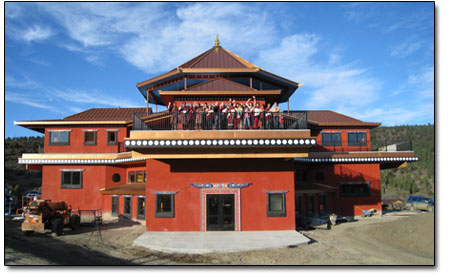|
| ||
| Shangri-La in the San Juans
by Jules Masterjohn Early in April, on a snowy spring day, I ventured into the mountains near Pagosa Springs, past a locked gate, and down a muddy road. I knew that I was going to an open house at the Tara Mandala Retreat Center, but I had no idea that I would discover a modern day Shangri-La so close to home. Nestled on 700 acres of the HD Mountains, Tara Mandala was founded by the first western woman to be ordained as a Tibetan nun, Lama Tsultrim Allione. Under Lama Tsultrim’s guidance, the Tara Mandala community has recently completed the construction of a grand Buddhist temple. Its architectural design came to Lama Tsultrim in a visionary dream over 40 years ago. The idea to build “a three-dimensional mandala in the form of a temple in the West,” however, was born 15 years earlier during her extended stay in Asia. This may seem like a long time to hold a vision, yet for a Tibetan practitioner and a teacher as celebrated as Lama Tsultrim, sustaining visualizations is a well developed spiritual practice. Visualization is used in Tibetan Buddhist meditation to help the practitioner cultivate qualities embodied by a specific deity such as Tara, the female Buddha of compassion, for example. The use of statues, paintings and other sacred art forms are the basis for these visualizations, placing art at the foundation of Tibetan Buddhism. Upon entering the temple at Tara Mandala, the first impression is one of awe. I nearly lost my breath in the presence of so much intricate pattern and vibrant color. It was hard to comprehend the amount of dedication and time put into crafting the carved and painted lintels over the 80 doorways and windows, all covered with involved patterns, sacred symbols, deities and bright colors. The temple is unlike any structure in our region and is an exquisite example of the ornate style found in Tibetan art and architecture, long-influenced by Chinese art and culture. At the center of the temple’s artistry is master painter Lama Jyurme Roujie, whose in-depth knowledge of Tibetan Buddhist culture informs the artwork. He has designed and painted every lintel and column carvings and is in the process of painting the carved wood throne. He will soon begin the interior mandalas and frescoes that will cover the temple walls. Assisting Lama Jyurme are three skilled woodcarvers from Bhutan. Each follows the master’s drawings effortlessly, working with hand tools to shape the many wooden elements that comprise the temple’s sacred imagery. As Lama Jyurme and the carvers work, it is a study in focused attention and deep concentration – no music was playing, no conversations taking place, only mindful activity. A combination of traditional Tibetan design and today’s “green” building practices, the temple is shaped in a 60-foot octagon. A carved and gilded shrine room occupies its center, surrounded by a circumambulation corridor. The numerous ornately carved and painted columns as well as the throne will soon be placed within the heart of the temple. Twenty-one bronze cast-and-gilded statues of Tara, adorned with semi-precious stones, will also be installed throughout the 12,000-square-foot structure. Four of the statues are currently at the retreat center, and the remaining statues are in Nepal being crafted by a family that has been making Buddhist statues for more than two centuries. The 3-foot tall, seated statues are graceful, elegant manifestations of Tara, who is known as the “mother of all Buddhas,” and is the namesake of the retreat center. The Tara Mandala temple is an embodiment of traditional Tibetan Buddhist symbolism. Built in three stories, the number has important significance. Each of the four doorways faces a cardinal direction, representing a specific aspect of the enlightened mind. Found extensively throughout the building are five basic colors – white, yellow, blue, red and green – and are used for their inherent transformative quality. Walking through the magnificent structure is like taking a sacred journey on which the spirit lifts as the mind calms. This was no coincidence, for the temple is designed to shift one’s consciousness from the mind-based preoccupations of human activity to the divine nature of being human. On my visit to Tara Mandala, I touched a deep sense of joy and wonder, and left with a soothing peacefulness that lingers into this moment. The scale and artistry of the temple possess the ability to profoundly affect human beings. It also has “transformed the landscape into a spiritual generator” of sorts, offering a space for traditional Tibetan practice as well as, perhaps, visits by such esteemed teachers as His Holiness the Dalai Lama. Situated in the pristine wilderness, the jewel-like temple is truly a place worthy of pilgrimage, one of the few power places in America manifested from one woman’s visionary dream. • Tara Mandala Retreat Center hosts retreats, programs, and open houses throughout the year. Visit www.taramandala.org or call (970) 731-3711 for information.
|


